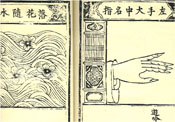


Copyright 2008
Mingmei Yip



New York Qin Music
Mingmei’s love for qin music



Me and my teacher




Confucian playing the qin

Playing the qin in nature

Guan Yin playing the qin,
painting by Mingmei

Qin fingering compared
to a soaring phoenix

Qin tablature,
C alligraphy by Mingmei.




My great love in music is the qin – the most ancient Chinese stringed instrument. When I first heard this instrument, not only was I captivated by its heavenly tunes, I was also fascinated by the players’ fingerings and sophisticated hand choreography. I’d never heard music so simple and soft, yet powerful!
In my novel Peach Blossom Pavilion, the courtesan Precious Orchid, is an accomplished qin player. This will be the first time that the qin is depicted in a novel published by a mainstream US publisher.
I was very lucky that one of the last masters of the ancient tradition, Mme Tsar
Teyun, lived in Hong Kong and accepted me as a student. She was one of the few alive
who had been trained in the refined style of the scholar-
Therefore, when I was awarded a scholarship to study music in Paris, I decided to write my Ph. D dissertation on the qin, with emphasis on its history, aesthetics and music theory. Since then, I have published over fifty qin articles and two books. The Art of Guqin Music (Commercial Press) and Guqin Music and Chinese Culture (Zhonghua Bookstore) are being reprinted in China. My third book on the qin will be Forbidding Emotion: Qin Music and Chinese Culture, in English, to be published with my CD. (To see my books on the qin, please go to “My Other Books and Writings.")
For my research, I’m particularly interested in the qin’s aesthetics and philosophy. I like to compare the different fingerings with images in nature, exploring the relationship between the qin and painting, calligraphy, and poetry. Cultivation through qin playing to promote longevity and virtue, fascinate me endlessly.
When I am not writing or doing research, I spend many hours playing the qin. I particularly enjoy performing on the qin, playing Confucian, Daoist and Buddhist pieces. For some pieces I accompany the instrument with my own singing in traditional Chinese style.
My qin repertory contains about fifty pieces, including my own compositions. While
I enjoy the after-
In recent years, feeling that traditional qin songs lack the popularity and attention they deserve, I have begun to compose songs for the qin, using both traditional and my own poems as lyrics. My works are widely performed in China and the US, most recently at the City University of New York. I have composed twenty qin pieces to accompany famous Chinese poems, including Li Bai’s Drinking Alone under the Moon, Ouyang Xiu’s The Butterfly Adoring the Flowers, Li Yu's Beauty Yu and Joyful Encounter, Li Qingzhao’s Sound of Lament.
More about the Qin {{pic 6, caption: A Tang dynasty (618-
The qin (pronounced chin) produces a delicate sound from seven silk strings. It was considered one of the four artistic pursuits, along with calligraphy, painting and poetry.
Intended for self-
The influence of Buddhism, though not as dominant as the other two, can be found in pieces such as Incantation of the Monk Puan, Heart Sutra, Naluo Dharma Song, and a few others.
The earliest qin is 2500 years old, found in an nobleman’s tomb. The earliest known composition is Youlan, Solitary Orchid. The title refers to Confucius, whose wisdom received no official recognition during his lifetime. While playing this piece I always imagine orchids swaying in the breeze symbolizing the lonely melancholy of Confucius. I feel as if I were eavesdropping on the great philosopher’s most intimate thoughts from more than two thousand years ago!
While the qin’s timbre is pure, simple, and tranquil, close to the spirit of Zen,
its complex fingerings and many-
The subtle tones of the qin are realized by its complex and sophisticated fingerings which, according to theory, amount to almost a hundred. While playing, interaction of the two hands creates an elegant, harmonious choreography, a visual pleasure comparable to ballet.
Qin tablature does not indicate pitch, only fingerings such as how to pluck, press,
or move to and fro on the sound board. To decipher a tablature, especially if its
fingerings are unfamiliar and its phrasing unclear, is a long and difficult process.
This reconstructing procedure is called da-
Besides instrumental pieces, the qin can also accompany singing. Many of the works of the great Chinese poets such as Wang Wei, Bai Juyi, Li Bai, Su Dongpo, and Li Qingzhao have been set to qin music. Subjects include: love, parting of friends, lamenting the pains of existence, spring outings, the changing seasons and everyday activities such as pounding clothes.
Starting from the Cultural Revolution (1965-
Recently the qin was designated by the United Nations as part of humanity’s intangible
heritage. This international recognition has caused the qin’s popularity in China
to surge. Instead of being played mainly for self-


